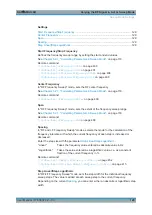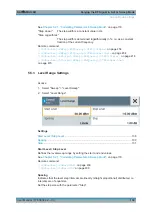
Improving Level Performance
R&S
®
SMA100B
143
User Manual 1178.3834.02 ─ 03
6 Improving Level Performance
To comply to the measurement requirements, the R&S
SMA100B features various
functions to optimize the RF signal level:
●
Attenuator
The large output level range is provided by a fast and wear-free switching elec-
tronic step attenuator.
It provides also the generation of a constant VSWR (uninterrupted level) signal,
highest level accuracy, noise suppression or compensation of external losses of
cables.
See
●
ALC
The automatic level control system stabilizes the RF signal level over temperature
and time.
See
●
UCOR
The user correction function allows you to compensate external losses (e.g. of
cables) to achieve an input level of highest accuracy at the DUT.
See
●
Power sensors
The R&S NRP power sensors support RF signal level optimization by determining
the attenuation characteristics of downstream devices or cables, or by monitoring
the RF signal level at the output directly.
You can configure the measurement parameters of a power sensor directly in the
R&S
SMA100B and monitor its readings, including calibration and firmware update.
Chapter 6.4, "Using Power Sensors"
6.1 Attenuator
The R&S
SMA100B is equipped with an electronic step attenuator unit that supports
RF wear-free level setting.
About the attenuator
The attenuator is an electronic component which enables you to vary the amplitude of
the RF signal. Basically, it is characterized by low VSWR (voltage standing wave ratio)
up to 20 GHz over the full level range.
According to the requirements of your application, you can select different attenuator
characteristics.
The following are examples of test requirements and the corresponding configuration:
●
Automatic configuration
Select standard operation mode ("Auto"), in which the generator adjusts the attenu-
ation of the RF output signal automatically
●
Compensation for cable loss
You can compensate the loss of a cable connection by a higher output power
Attenuator
















































